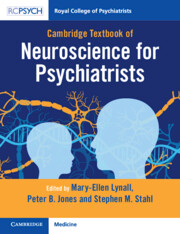Book contents
- Cambridge Textbook Of Neuroscience for Psychiatrists
- Reviews
- Cambridge Textbook of Neuroscience for Psychiatrists
- Copyright page
- Contents
- Contributors
- Introduction
- 1 Cells
- 2 Neurotransmitters and Receptors
- 3 Basic Techniques in Neuroscience
- 4 Neuroanatomy
- 5 Neural Circuits
- 6 Modulators
- 7 Genetics
- 8 Neurodevelopment and Neuroplasticity
- 8.1 The Development of Brain Structure and Function
- 8.2 Neurodevelopmental Models of Psychiatric Disorders
- 8.3 Attachment
- 8.4 Neuroplasticity
- 8.5 Intelligence and Intellectual Disability
- 9 Integrated Neurobiology of Specific Syndromes and Treatments
- 10 Neurodegeneration
- Index
- References
8.1 - The Development of Brain Structure and Function
from 8 - Neurodevelopment and Neuroplasticity
Published online by Cambridge University Press: 08 November 2023
- Cambridge Textbook Of Neuroscience for Psychiatrists
- Reviews
- Cambridge Textbook of Neuroscience for Psychiatrists
- Copyright page
- Contents
- Contributors
- Introduction
- 1 Cells
- 2 Neurotransmitters and Receptors
- 3 Basic Techniques in Neuroscience
- 4 Neuroanatomy
- 5 Neural Circuits
- 6 Modulators
- 7 Genetics
- 8 Neurodevelopment and Neuroplasticity
- 8.1 The Development of Brain Structure and Function
- 8.2 Neurodevelopmental Models of Psychiatric Disorders
- 8.3 Attachment
- 8.4 Neuroplasticity
- 8.5 Intelligence and Intellectual Disability
- 9 Integrated Neurobiology of Specific Syndromes and Treatments
- 10 Neurodegeneration
- Index
- References
Summary
Brain development is mediated by a series of coordinated and often genetically programmed events, simultaneously signalling the growth of the entire brain while harmoniously guiding the emergence of local structure, function and connections of numerous brain regions. This process of ‘normative’ or ‘typical’ brain development, from gestation through adolescence, creates a biological scaffold that gives rise to complex traits such as cognition, educational achievement and socio-affective functioning. In addition to the relevance of healthy brain development for these phenotypes (Paus et al., 2008; Gilmore et al., 2018;), it is pivotally important for understanding neurodevelopmental disorders (e.g. autism, attention deficit hyperactivity disorder, anxiety disorders, depression, schizophrenia, etc.), which are conceptualised as arising from some form of deviation from typical brain maturation (see Section 8.2). Using non-invasive neuroimaging techniques, such as magnetic resonance imaging and diffusion tensor imaging, early studies have provided an intriguing first picture of brain growth trajectories and changes in structure, function and connectivity. Below, we highlight particularly critical periods of lifespan brain maturation and senescence, and describe the neurobiological phenomena at the microscale that are coincidental with these global and local effects queried at the macroscale.
- Type
- Chapter
- Information
- Cambridge Textbook of Neuroscience for Psychiatrists , pp. 343 - 348Publisher: Cambridge University PressPrint publication year: 2023

